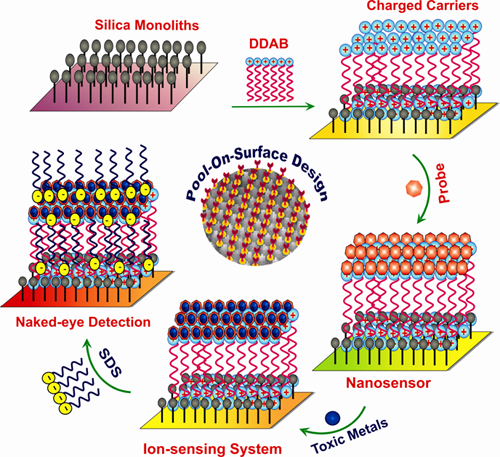Optical Nanoscale Pool-on-Surface Design for Control Sensing Recognition of Multiple Cations
Innovative Materials Engineering Laboratory, Nano-dynamic Materials Designs Group, NIMS
Sherif A. El-Safty
Research Center for Compact Chemical Process (CCP), AIST
Adel A. Ismal, Hideyuki Matsunaga, Takaaki Hanaoka and Fujio Mizukami
Researchers of NIMS and AIST report a simple yet general method that they called the "building-blocks" approach of optical chemical nanosensors.
Abstract
Human health risks associated with the increased release of toxic metals have drawn attention to their vectors of presentation. In addition, there is an increasing interest in determination hazardous heavy metals at trace level, because they are definitely highly toxic for biological systems, with mutagenic and potential carcinogenic properties. To the best of our knowledge, no general design for optical nanosensor arrays has been reported that incorporates simplicity in terms of fabrication time and low-cost materials but still retains sensitivity and fast-response detection of multiple toxic cations. Thus, general design of optical chemical nanosensors is needed to develop efficient sensing systems with high flexibility, and low capital cost for control recognition of toxic analytes. Here, we extensively report a simple yet general method that we called the "building-blocks" approach of optical chemical nanosensors. This design strategy is an approach based on a dense pattern of immobilized hydrophobic and hydrophilic molecular receptors with intrinsic mobility via extremely robust constructed sequences onto 3D nanoscale structures without the common use of silane- or thiol-coupling coupling agents (Scheme 1).

Scheme 1
Pool-on-Surface design for optical chemical
!["Fig. 1Simple naked-eye detection of ultra-traces of toxic [CrVI] ions in water waste" Image](/eng/news/archive/2008/05/hdfqf10000003ky7-img/hdfqf10000003l11.jpg)
Fig. 1
Simple naked-eye detection of ultra-traces of toxic [CrVI] ions in water waste
To extend the applicability of this approach, a variety of nanoscale pore geometry and shape, and particle morphology was used as carriers to sensitive and selective discrimination of trace level of toxic analytes. A key advantage in this approach is the ability to create highly accessible, flexible, and fine-tuned surface probes that make the character of the sensing systems likely to be pool-on-surface in which high flux of the metal analytes across the indicator molecules is rapidly achieved. Evidence for the fidelity of control design of optical nanosensors was that the "pool-on-surface" sensing systems exhibited efficient recognition and signaling of multiple metal Cr(VI), Pb(II), Co(II), and Pd(II) ions (Fig. 1). Key to our development design is that although these chromophore moieties are used for sensing recognition of metal ions in solution up to ~10-6-10-7 mol/dm3, our nanosenors enabled to create sensing system responses with revisable, selective and sensitive recognition of wide range of detectable ions down to sub-picomolar (~10-11 mol/dm3), for first time, in rapid sensing responses (in the order of seconds).
This article was published on-line by Advanced Functional Materials on May 15, 2008

!["Fig. 1Simple naked-eye detection of ultra-traces of toxic [CrVI] ions in water waste" Image](/eng/news/archive/2008/05/hdfqf10000003ky7-img/hdfqf10000003l11.jpg)
